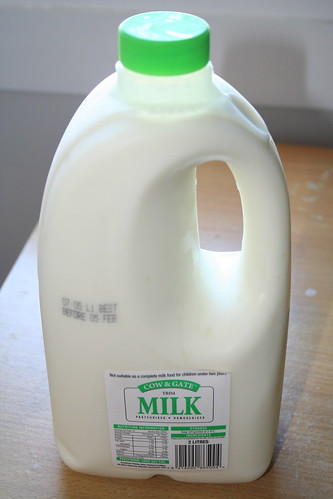Home-made yogurt
One of my regular expenses was for sachets of yogurt. The standard approach to making your own yogurt in New Zealand, is to buy a yogurt maker and then to buy a sachet of yogurt powder for each batch you make from then on. I have the most well known and commonly available brand, which is Easiyo. The price for a sachet is around $3.00NZ.
So reading about people making their own yogurt from milk and a residual amount of their previous batch, sounded like it was worth trying for myself. Milk is quite expensive, reaching around $4.00NZ for 2 liters, but it is possible to find lesser known brands for as little as $2.50NZ.
The process is that the milk is first heated up, then cooled down, then an amount of the existing yogurt is mixed in and finally the mix is left to ferment or yogurtify or whatever the technical term is.
Heating the milk:
The homemade yogurt:
The first time I made it, I followed the process in the given link directly. The resulting yogurt was a consistent texture noticeably thicker than the milk that went into it. It still qualified as runny, being nearer the milk than the thickness that greek yogurt is expected to be. No whey separated either in the resulting batch, or in the yogurt as it sat in the fridge for a week.
I've made it twice since, and reading somewhere else that higher temperatures made for thicker yogurt, I've altered the process somewhat. The difference is that I heat the milk for half an hour longer and let it sit half an hour shorter. The yogurt that results from this is thicker, but is accompanied by a reasonable amount of whey. The yogurt looks almost like a round cheese within the whey.
I'd be worried about the separation but I've also seen it in Easiyo I have made, and from what have I read on the internet it is good for you. As I put the resulting yogurt back in the cleaned milk container, with the older yogurt adding to the volume I end up with a little more than fits in the container. So I discard a small amount of whey to leave me with approximately 2 liters, and then mix the remaining yogurt and whey before pouring it into the container.
It tastes pretty good. The yogurt from a sachet usually tastes slightly bitter, which I understand may be because of the milk powder that goes into it. The sachet yogurt is also made from tap water which can be heavily chlorinated or florinated or something and tastes like it. The home made yogurt is made from whatever milk the cows drunk, which does not.
Making yogurt this way makes twice the yogurt at under half the price. Definitely worth it, even if it does take over 14 hours to do.
No comments:
Post a Comment